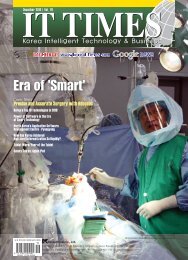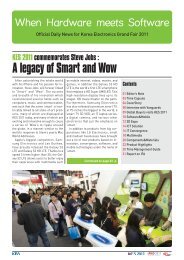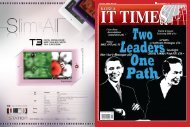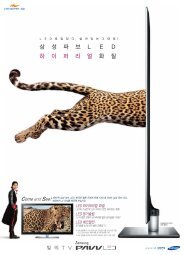Shooting for Goal! FIRA RoboWorld Cup 2006 ... - Korea IT Times
Shooting for Goal! FIRA RoboWorld Cup 2006 ... - Korea IT Times
Shooting for Goal! FIRA RoboWorld Cup 2006 ... - Korea IT Times
Create successful ePaper yourself
Turn your PDF publications into a flip-book with our unique Google optimized e-Paper software.
<strong>2006</strong>-06-1<strong>2006</strong>.6.701:57PM페이지14001채널맥(3443-0701)<br />
Innovative Technology<br />
/ KDC 3D<br />
KDC Leaps Ahead with 3D Technology<br />
Becomes first company in the world to set up a stereoscopic 3D LCD production line<br />
Expert Column<br />
/ IPv6<br />
Always-On IP Sessions Using Mobile IPv6<br />
The writer is a senior member of the research staff in the Mobile Convergence<br />
Laboratory of Samsung Electronics, <strong>Korea</strong>. He is a member of the IPv6<br />
International Forum....Ed.<br />
<strong>Korea</strong>’s KDC Corporation (www.<br />
kdccorp.co.kr) has developed new<br />
stereoscopic 3D technology with<br />
Master Image Co., Ltd. which is a stereoscopic<br />
3D display specializing company<br />
since 2004. KDC is in charge of manufacturing<br />
and co-marketing.<br />
The new stereoscopic 3D display technology<br />
has no need <strong>for</strong> 3D glasses, unlike<br />
the existing technology which requires<br />
wearing of 3D glasses.<br />
The potential <strong>for</strong> the application of this<br />
technology is huge, considering the fact<br />
that the <strong>Korea</strong>n Ministry of In<strong>for</strong>mation<br />
and Communication (MIC) has announced<br />
plans <strong>for</strong> every display in <strong>IT</strong> devices -<br />
including telephones, TVs and recording<br />
devices - to be changed to stereoscopic 3D<br />
display.<br />
In <strong>2006</strong>, major mobile phone makers<br />
are planned to release the stereoscopic display<br />
phones. Many contents providers<br />
related to broadcasting, movie, game,<br />
advertisement, entertainment are expected<br />
to appear.<br />
KDC has the distinction of becoming<br />
the first company in the<br />
world to set up a<br />
stereoscopic 3D<br />
LCD production<br />
line. Founded in<br />
1972 as the first <strong>IT</strong>-specialized<br />
company in <strong>Korea</strong><br />
KDC was the nation’s first<br />
Modem (1200 bps) provider and<br />
developed its own models. It<br />
was also the first outsourcing<br />
service provider of network integration<br />
& maintenance (1989).<br />
KDC has installed integrated<br />
networks <strong>for</strong> the <strong>Korea</strong>n government,<br />
financial institutions, communications<br />
carriers, etc.,<br />
resulting in the most business integration in<br />
<strong>Korea</strong>.<br />
KDC was selected as a promising communications<br />
company by government<br />
authorities, and was the first to be KOS-<br />
DAQ-listed among <strong>IT</strong>-related companies<br />
in <strong>Korea</strong> (1996). It was the first to be ISO-<br />
9001-approved among <strong>IT</strong>-related companies<br />
in <strong>Korea</strong> (2000) and acquired TL9000<br />
certification in 2005. KDC was<br />
inaugurated as the Seoul<br />
Metropolitan Area terrestrial<br />
DMB business provider “DMB<br />
Plus” in 2004 and became<br />
<strong>Korea</strong>’s first PC-based groundwave<br />
DMB receiver development.<br />
Innovative products developed<br />
by KDC include the<br />
Stereoscopic LCD <strong>for</strong> mobile<br />
phones etc., the Stereoscopic<br />
large Screen System, the<br />
Stereoscopic Kiosk (an in<strong>for</strong>mation<br />
terminal with HD micro<br />
display module <strong>for</strong> 40 inch<br />
wide screen); a Stereoscopic<br />
Camera; a Stereoscopic Advertising Panel;<br />
and a 3-side Conversion POP applying<br />
lenticular technology<br />
Stereoscopic images show left and right<br />
images on stereoscopic display using a twolens<br />
type of distinctive stereoscopic technology<br />
in contrast to existing 3D (Single-lens<br />
type)<br />
The auto stereoscopic LCD is based on<br />
individualized parallax barrier design technology<br />
offering world-best viewing area<br />
and brightness. It is customizable to various<br />
LCD sizes and 2d/3D mode is alterable to<br />
stereoscopic 3D mode<br />
It provides customers Total Stereoscopic<br />
Solution <strong>for</strong> Mobile Devices with:<br />
* Stereoscopic LCD<br />
* Stereoscopic Handset Camera Module<br />
* Stereoscopic Soft-ware (e.g., viewer,<br />
UI)<br />
* Stereoscopic Content<br />
KDC is clearly growing from strength to<br />
strength with its latest success in taking an<br />
early lead in the Stereoscopic 3D Display<br />
Business shows that it is not only <strong>Korea</strong>’s<br />
chaebol (conglomerates) that are leading the<br />
world in pioneering new <strong>IT</strong> technologies.<br />
By Daniel Soohong Park<br />
Mobile Convergence Laboratory,<br />
Samsung Electronics.<br />
The next few years promise to be truly<br />
revolutionary, with the introduction of<br />
broadband wireless services. With the<br />
global deployment of 3G and WiFi networks<br />
now under way, users will be able to<br />
experience a new range of mobility and<br />
multimedia services - but as separate networks.<br />
Un<strong>for</strong>tunately one major function<br />
that has not been developed is a roaming<br />
solution to allow users to move in and out<br />
of various public 3G/WiFi and private<br />
WiFi networks without session restarts.<br />
However this is where Mobile IPv6 can<br />
play a powerful role.<br />
Built on IPv6, Mobile IPv6 enables the<br />
creation of always-on IP sessions that keep<br />
users connected as they travel from their<br />
home to office to hot spots without having<br />
to restart an application. Unlike Mobile<br />
IPv4, which is based on resource intensive<br />
signaling and tunneling, mobility was<br />
designed into IPv6 protocol to enable<br />
instant connectivity with minimal overhead.<br />
Mobile IPv6 also features route optimization<br />
that helps ensure that the best<br />
path between the user and home network is<br />
established so that backbone bandwidth is<br />
never wasted. And finally because Mobile<br />
IPv6 enables end-to-end connectivity,<br />
users are assured security without the fear<br />
of NAT (Network Address Translation).<br />
For service providers and more importantly<br />
users 3G-WiFi roaming promises to<br />
enable always on broadband wireless connectivity.<br />
To achieve a seamless mobility<br />
requires us to solve a number of problems<br />
be<strong>for</strong>e broadband wireless roaming<br />
becomes a reality. First, different signaling<br />
protocols are being used by 3G and WiFi.<br />
Second the very high scale of the problem,<br />
with millions of mobile user needs to be<br />
addressed. And third, security issues surrounding<br />
the transmittal of corporate data<br />
need also to be solved. We also need to be<br />
address different usage scenarios including<br />
when a mobile node roams into a 3G<br />
domain or when a 3G node roams into an<br />
unknown WiFi network. In summary 3G-<br />
WiFi roaming has the dynamics of very<br />
complex problems.<br />
Mobile IPv4 was developed as an addon<br />
feature to the IPv4 protocol. Thus its<br />
deployment requires the use of overlay<br />
Mobile IPv4 routers, compute intensive<br />
signaling to set up a connection and the use<br />
of tunnels once a connection is set up. In<br />
addition to the obvious problem of having<br />
to buy hardware, Mobile IPv4’s signaling<br />
and tunneling cost increase proportionally<br />
with the number of mobile users and their<br />
throughput requirement. Subsequently on<br />
reason why service providers stayed away<br />
from Mobile IPv4 deployments was that<br />
users would likely start experiencing long<br />
delays and/or temporary disconnections as<br />
the per<strong>for</strong>mance limit of the protocol was<br />
reached. Another problem with Mobile<br />
IPv4 is that IPv4 addresses are logical<br />
Identifiers that are used to represent at the<br />
same time the destination host and its topological<br />
position on the whole network.<br />
Topological addressing simplifies routing<br />
in a fixed network environment but<br />
becomes a big problem in a mobile one.<br />
Mobile IP permits users to remain connected<br />
across wired (e.g., Ethernet, xDSL)<br />
and wireless (e.g., 802.11, Cellular,<br />
Satellite, 3G) networks while roaming<br />
from one network to another. This permits<br />
the user to stay connected in route to the<br />
airport from home, rather that shutting<br />
down their PDA/Laptop at home, and<br />
reconnecting at the WiFi location at the airport.<br />
Mobility in Mobile IPv6 is facilitated<br />
by having the Mobile Node contact its<br />
Home Agent with its current location. The<br />
Home Agent is a router that maintains the<br />
location state <strong>for</strong> the Mobile Node as it<br />
moves and stores the in<strong>for</strong>mation as a<br />
Care-of-Address. This simple but powerful<br />
feature which is built into the IPv6 protocol<br />
enables all mobile hosts to be reachable<br />
without the need of the service provider to<br />
purchase/deploy extra devices or waste<br />
bandwidth due to tunneling. Another powerful<br />
feature of Mobile IPv6 is that it<br />
enables a Mobile Node and the IP service<br />
host also referred as a Correspondent Node<br />
to communicate directly without going<br />
through a Home Agent by the use of the<br />
Mobile IPv6 Route Optimization. This is<br />
done using a procedure defined as Return<br />
Routability (RR) within the Mobile IPv6<br />
protocol in which the network path<br />
between the Mobile Node and<br />
Correspondent Node is secured through the<br />
RR procedure. Once this happens packets<br />
can be directly <strong>for</strong>warded between the<br />
communicating parties without the need<br />
<strong>for</strong> the Home Agent.<br />
In summary, Mobile IPv6 offers to revolutionize<br />
the telecommunications and<br />
consumer products by enabling truly<br />
always-on broadband connectivity <strong>for</strong><br />
mobile computing devices. When 3G is<br />
combined with WiFi ones’ office LAN can<br />
now have a global footprint. Looking to the<br />
future, Mobile IPv6 promises to help create<br />
a new generation of consumer and enterprise<br />
application like personal content<br />
delivery services, multimedia e-collaboration<br />
and virtual Private Mobile Radio<br />
replacement just to name a few. The elegance<br />
and cost effectiveness of Mobile<br />
IPv6 is certain to be an important element<br />
of tomorrow’s mobile multimedia networks.<br />
1 4 _ June <strong>2006</strong> KOREA <strong>IT</strong> TIMES<br />
KOREA <strong>IT</strong> TIMES June <strong>2006</strong> _ 1 5

















